Morocco travel - Maroc, North Africa
Morocco, officially the Kingdom of Morocco, sits in the northwest corner of Africa, offering a unique blend of Mediterranean and Atlantic coastlines. Bordered by the Mediterranean Sea to the north and the Atlantic Ocean to the west, it shares its eastern border with Algeria and its southern border with the disputed territory of Western Sahara. Spanning around 446,550 square kilometers (172,413 square miles), Morocco boasts a diverse landscape that ranges from vibrant coastal plains to majestic mountains and vast desert expanses, making it a country of stunning contrasts and natural beauty.
Population: Estimate 38,000,000 people (as of 2024)
Economy: Tourism plays a vital role in Morocco's economy, standing as the third most important sector after agriculture and industry. In 2021, it contributed an impressive $9 billion to the country’s GDP.
Landmarks: Hassan II Mosque, Djemaa el-Fna Square, Majorelle Garden, Bahia Palace, Sahara Desert, Chefchaouen Medina, Citadel of Ait Ben-Haddou
maroc
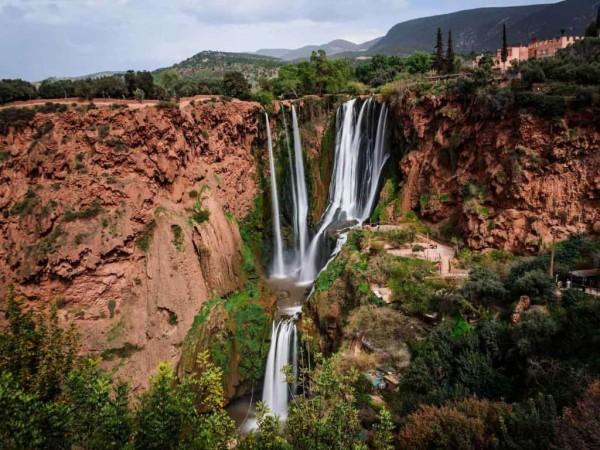
Overview of Morocco
History & Cultural Influence
Morocco's rich history stretches back thousands of years, deeply shaping its cultural and national identity. Inhabited by Berber tribes as early as 2000 BCE, the region saw influences from Phoenicians, Romans, and later, the Islamic conquest in the 8th century, which introduced Arabic and Islam, laying the foundation for Morocco’s cultural and religious landscape. Over the centuries, successive dynasties like the Almoravids, Almohads, and the current Alaouite dynasty unified the region and expanded Morocco’s influence across North Africa and into Spain. French colonial rule in the 20th century further impacted the country before Morocco regained its independence in 1956.
Culturally, Morocco is a vibrant blend of Berber, Arab, and European influences, reflected in its architecture, art, and daily life. Iconic landmarks like the Koutoubia Mosque and the ancient medinas of Fez and Marrakech showcase this rich heritage. Moroccan cuisine, known for its fusion of Berber, Arab, and Mediterranean flavors, is celebrated globally. Today, Morocco's unique history continues to shape its modern identity, balancing tradition and modernization, with its strategic location making it a cultural bridge between Europe and Africa and a top destination for tourists worldwide.
Interaction with The Locals
When interacting with locals, you’ll find that Moroccans take great pride in their heritage and are eager to share it with you. Whether it’s through music, dance, or the rich flavors of Moroccan cuisine, there’s a strong sense of cultural exchange. A visit to the local markets, or souks, is a fantastic way to immerse yourself in this vibrant culture, with vendors often willing to bargain and share stories about their goods.
While Arabic and Berber are the official languages, you’ll notice that many Moroccans, especially in the cities, speak French—a legacy of the country’s historical ties with France. English is also becoming more common, particularly among the younger generation and in tourist hotspots, making it easier for visitors to communicate.
Your experience in Morocco might vary depending on whether you’re in an urban or rural area. In bustling cities like Marrakech and Casablanca, you’ll encounter a cosmopolitan vibe, with locals who are accustomed to interacting with tourists. On the other hand, rural areas offer a more traditional experience, where customs are closely tied to local culture, and interactions can feel more personal and intimate.
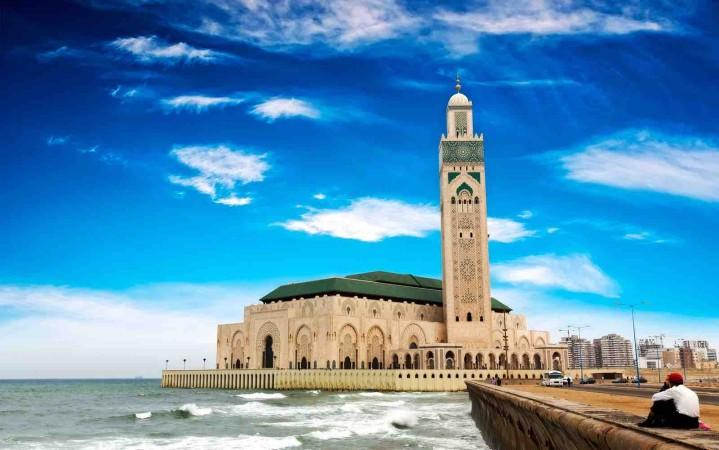
Hassan II Mosque - © posztos
Top attractions in Morocco
Morocco offers an array of captivating attractions, from the majestic Hassan II Mosque in Casablanca, one of the largest mosques in the world, to the enchanting blue-washed streets of Chefchaouen in the Rif Mountains. Travelers can explore the vibrant Marrakesh Medina, a UNESCO World Heritage site, or experience the breathtaking beauty of the Erg Chebbi dunes in the Sahara Desert, making Morocco a destination rich in culture, history, and natural wonders.
Hassan II Mosque
Location: Bd Sidi Mohammed Ben Abdallah in Casablanca
Perched on the Atlantic coast, the Hassan II Mosque in Casablanca is one of the largest mosques in the world and a true architectural marvel. It’s also the only mosque in Morocco open to non-Muslims, offering guided tours that showcase its intricate mosaics, stunning carvings, and religious significance. Don’t miss the breathtaking views from its observation deck, where the ocean seems to blend seamlessly with the sky.
Chefchaouen
Location: Rif Mountains, Northern Morocco
Welcome to Chefchaouen, Morocco’s enchanting "Blue City." Nestled in the Rif Mountains, this town is famous for its blue-painted buildings that create a surreal, dreamy atmosphere. It’s a photographer’s paradise, with narrow streets lined with local handicrafts and the backdrop of stunning mountain scenery. Whether you’re exploring the peaceful streets or hiking the surrounding hills, Chefchaouen’s unique charm is sure to captivate you.
Marrakesh Medina
Location: Marrakech
Step into the vibrant heart of Marrakech at the Marrakesh Medina, a UNESCO World Heritage site teeming with life. The bustling souks, historic palaces, and lively squares are just the beginning. By day, you can lose yourself in the maze of market stalls, and by night, the famous Jemaa el-Fnaa square comes alive with food stalls and street performers. It’s a sensory overload in the best possible way, offering a true taste of Moroccan culture.
Essaouira
Location: Atlantic Coast
Known as the "City of the Winds," Essaouira is a coastal gem with a picturesque medina of whitewashed buildings accented with blue. This laid-back city is famous for its beautiful beaches, fresh seafood, and vibrant arts scene. Whether you’re into water sports, strolling along the historic ramparts, or exploring artisan shops, Essaouira offers a perfect blend of relaxation and culture.
Ait Ben Haddou
Location: Ouarzazate region
Ait Ben Haddou is a stunning mud-brick village that looks like it was plucked straight out of a movie—literally! This UNESCO World Heritage site has served as the backdrop for films like "Gladiator" and "Game of Thrones." Its dramatic architecture and desert landscape make it a must-see for history buffs and film fans alike. Wander through its ancient streets and soak in the panoramic views from the hilltop—it’s like stepping back in time.
Volubilis
Location: Near Moulay Idriss
Step into ancient history at Volubilis, one of the best-preserved Roman ruins in North Africa. This archaeological site is known as a Unesco World Heritage site for its stunning mosaics and well-preserved structures that offer a glimpse into Roman life in the region. Whether you’re a history enthusiast or just curious, exploring Volubilis is like taking a journey through time.
Erg Chebbi Dunes
Location: Merzouga, on the far western edge of the Sahara Desert
The Erg Chebbi dunes in the Sahara Desert are the stuff of dreams. These towering golden sand dunes can reach heights of up to 150 meters, offering some of the most iconic landscapes in Morocco. Experience the magic of the desert with a camel trek, watch the sun set over the dunes, and spend the night in a traditional desert camp under a blanket of stars. It’s an adventure you won’t forget.
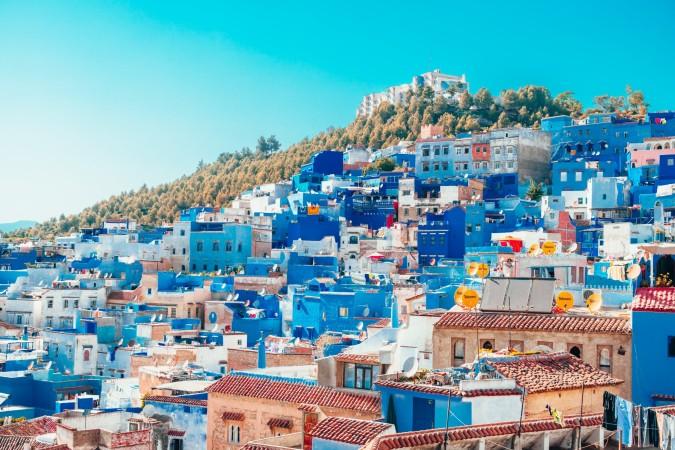
Chefchaouen - © gather
Must-Try Dishes in Morocco
When visiting Morocco, be sure to try iconic dishes like Couscous, a staple meal of steamed semolina served with savory meats and vegetables, often enjoyed communally. Don’t miss out on Tagine, a flavorful slow-cooked stew prepared with a variety of ingredients, from tender lamb to fresh vegetables, all infused with aromatic spices. For a unique taste experience, try Pastilla, a sweet and savory pastry that blends spiced meat with layers of flaky pastry, dusted with cinnamon and powdered sugar.
Couscous
Couscous is one of Morocco’s most iconic dishes, made from steamed semolina wheat granules and typically served with a mix of meats like lamb or chicken, along with a variety of vegetables. Traditionally enjoyed on Fridays, this hearty meal has become a staple throughout the week, symbolizing hospitality and togetherness as it’s often eaten from a shared dish.
Tagine
Tagine, named after the earthenware pot in which it’s cooked, is a slow-cooked stew that’s a cornerstone of Moroccan cuisine. It features a variety of ingredients, from chicken and lamb to fish and vegetables, all seasoned with spices like cumin, saffron, and cinnamon. Each region offers its own twist on this versatile dish, celebrated for its ability to meld flavors into tender meats and rich sauces.
Pastilla
Pastilla, also known as bastilla, is a unique Moroccan pastry that masterfully blends sweet and savory flavors. Typically made with pigeon or chicken, it layers spiced meat and nuts within flaky pastry, then dusted with powdered sugar and cinnamon. Often served at special occasions, pastilla is a symbol of Morocco’s culinary fusion and a must-try for visitors.
Harira
Harira is a traditional Moroccan soup made from tomatoes, lentils, chickpeas, and lamb, especially popular during Ramadan. Served to break the fast at sunset, this hearty soup is often accompanied by dates and bread, embodying comfort and the importance of sharing meals with loved ones during special occasions.
Tanjia
Tanjia is a specialty from Marrakech, traditionally prepared by men who marinate meat, usually lamb, with spices and cook it slowly in a sealed clay pot. This dish is a symbol of local culinary tradition and communal cooking, offering a unique and flavorful experience for those who try it.
Maakouda
Maakouda are Moroccan potato fritters, seasoned with spices and commonly enjoyed as street food. These small, deep-fried patties are often served in sandwiches with fresh vegetables and sauces, highlighting the vibrant street food culture in Morocco and showcasing the use of simple ingredients to create delicious snacks loved by both locals and visitors.
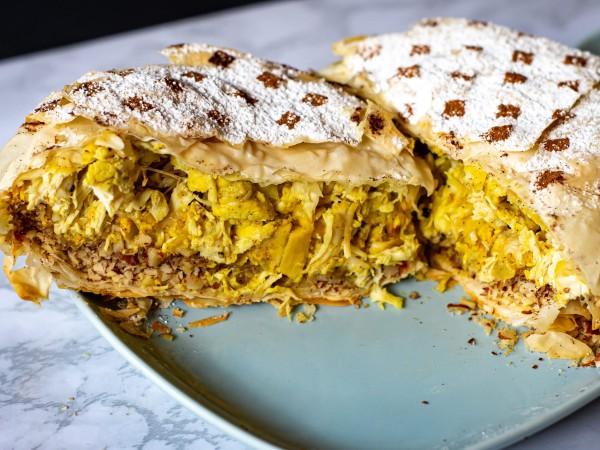
Pastilla - © gather
Festivals & Local Celebrations
Almond Blossom Festival
When: February
Celebrate the arrival of spring at the Almond Blossom Festival, where the hills of Tafraoute come alive with beautiful pink and white almond blossoms. Visitors can enjoy traditional Berber music and dance performances, browse stalls selling almond-based products, and take in the breathtaking views of the famous Blue Painted Rocks and the surrounding valley.
Imilchil Marriage Festival
When: September
The Imilchil Marriage Festival offers a unique glimpse into ancient Amazigh traditions as young couples gather to celebrate marriage. Visitors are treated to vibrant ceremonies and cultural rituals, providing a rare opportunity to witness and learn about Amazigh customs in the stunning backdrop of the High Atlas Mountains.
Gnaoua World Music Festival
When: June
Set against the picturesque coastal backdrop of Essaouira, the Gnaoua World Music Festival blends African, Arab, and Berber influences with contemporary world music. Visitors can experience energetic performances, all while soaking in the charm of Essaouira’s medina and enjoying a world-class celebration of Gnaoua culture.
Fez Festival of World Sacred Music
When: May/June
The Fez Festival of World Sacred Music is a mesmerizing cultural event that promotes interfaith dialogue through sacred music from around the globe. Visitors can attend unforgettable performances set in historic landmarks, like the ancient alleyways of Fez Medina, and immerse themselves in the spiritual and cultural richness of the festival.
Mawazine Festival
When: May/June
As the largest music festival in the world, the Mawazine Festival brings together some of the biggest names in music for outdoor concerts in Rabat. Visitors can expect an unforgettable experience with live performances from global superstars, all set against the vibrant and beautiful backdrop of Morocco’s capital city.

Almond Blossom Festival - © gather
Weather in Morocco: Best Time to Visit
Morocco boasts a diverse climate that shifts dramatically by region and season, offering a little something for everyone. The country experiences four main climate types:
- Mediterranean climate in the northern coastal areas brings hot, dry summers and mild, wet winters.
- Mild, semi-arid conditions on the Atlantic coast offer warm temperatures year-round, with moderate rainfall.
- Desert climate in the inland areas means scorching summers and cold winters, ideal for desert adventures.
- Continental climate in the mountainous regions delivers colder temps and snowfall in winter, perfect for snow lovers.
Average Temperatures and Rainfall
Northern Coastal Areas (Tangier, Tetouan, Rabat):
- Summer (June-August): Expect hot weather, with temperatures soaring above 30°C (86°F), occasionally reaching 40°C (104°F), and little to no rain.
- Winter (December-February): Mild days around 10-15°C (50-59°F), with cooler nights dropping to 5°C (41°F) or lower. Moderate rainfall keeps things fresh.
Atlantic Coast (Casablanca, Essaouira, Agadir):
- Summer: Warm and breezy, thanks to the Atlantic winds, with temperatures ranging between 20-30°C (68-86°F).
- Winter: Mild days, hovering around 15-20°C (59-68°F), and cooler nights around 8-12°C (46-54°F), with some moderate rainfall.
Inland Areas (Marrakech, Meknes, Fez):
- Summer: Scorching hot, often exceeding 40°C (104°F), making it perfect for those who enjoy the heat.
- Winter: Cold nights, sometimes below freezing, but daytime temperatures are more pleasant, around 20°C (68°F).
Mountains (Ifrane, High Atlas):
- Summer: Warm days with cool, refreshing nights.
- Winter: Cold and snowy, especially in the High Atlas, turning it into a winter wonderland.
Best Time to Visit
When to visit Morocco really depends on what you’re looking for:
- Spring (March-May) and fall (September-November) are ideal for mild weather and fewer crowds across most regions.
- Summer is perfect for a beach getaway along the Atlantic coast.
- Winter is best for exploring the Sahara Desert or the southern regions, where temperatures are more comfortable.
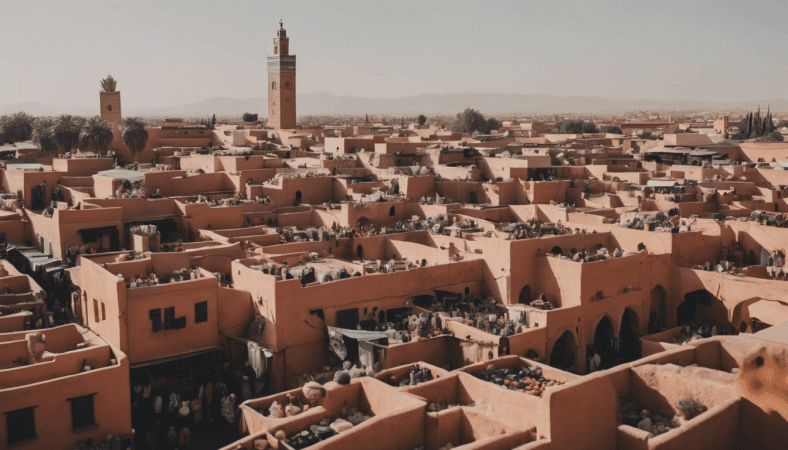
Marrakesh Medina - © gather
Culture Etiquette in Morocco
When visiting Morocco, it’s important to understand and respect local customs to ensure a positive and enriching experience. Here are some cultural practices to keep in mind:
Greetings
Traditional greetings hold a lot of significance in Morocco. When meeting someone, it’s polite to say "As-salamu alaykum" (Peace be upon you), to which the appropriate response is "Wa alaykum as-salam." Handshakes are common between men, but with women, it’s a bit different—some may only greet close friends or relatives this way. If you’re unsure, just wait for them to extend their hand first. If they don’t, a polite nod or slight bow is always a respectful option.
Dress Code
Modesty is key when it comes to dressing in Morocco, as it’s a predominantly Muslim country. Women should aim to wear long dresses or skirts with tops that cover the shoulders and chest, while men should stick to long trousers and shirts that cover the shoulders. And if you’re heading to the beach, swimwear is fine—but only at the beach!
Dining Etiquette
Moroccan meals are all about community and respect. It’s customary to eat, greet, and pass items with your right hand, as the left hand is considered unclean. If you’re invited to someone’s home, you may even be offered a basin to wash your hands before the meal. Before digging in, wait for your host to say "Bismillah" (In the name of God) as a blessing for the meal. Meals are often shared from a communal plate, and bread is typically used as a utensil. Oh, and don’t forget to remove your shoes when entering a Moroccan home—it’s a sign of respect!
Market Etiquette
When shopping in Morocco’s lively souks, haggling is not only accepted but expected! Prices are often inflated, so feel free to negotiate with a smile. Locals enjoy a friendly back-and-forth, and it’s all part of the authentic market experience.
Photography Etiquette
If you want to capture photos of locals, especially in rural areas, it’s always polite to ask for permission first. Some people may not wish to be photographed, and it’s important to respect that. In touristy spots, street performers may expect a small tip if you snap a picture, so keep that in mind.
Public Behavior
Public displays of affection, like kissing or hugging, are generally frowned upon in Morocco. It’s best to save those moments for private spaces. Also, if you’re visiting during Ramadan, be mindful of those fasting—avoid eating or drinking in public during daylight hours, and dress a bit more conservatively to show respect.
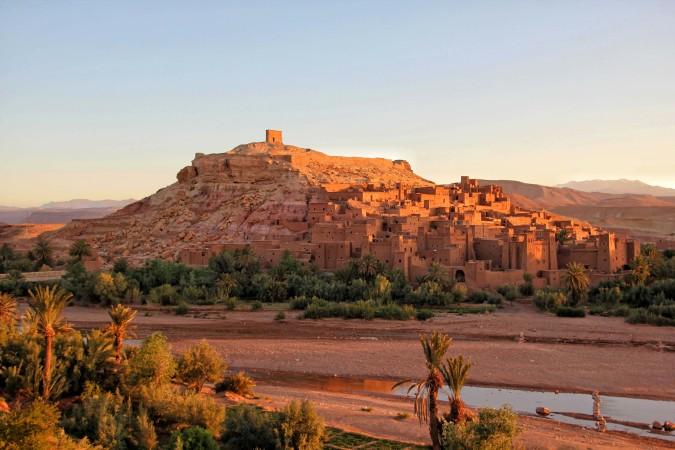
Ait Ben Haddou - © Jürgen Reichenpfader
Essential Travel Information
Transportation
Airport Transfers
Morocco’s major airports—Casablanca (CMN), Marrakech (RAK), Agadir (AGA), Fes (FEZ), and Rabat (RBA)—offer plenty of options to get you from the airport to your hotel or city center. You can choose between shared shuttle buses, private taxis, or pre-booked private transfers. Shared shuttles typically cost around 120-200 MAD ($12-20 USD), while private taxis range from 300-500 MAD ($30-50 USD), depending on the distance. For convenience and a set price, it’s a good idea to pre-book a private transfer, especially if you’re arriving after a long flight.
Public Transit
In cities like Casablanca, Rabat, and Marrakech, public buses are an affordable way to get around, with fares as low as 3-5 MAD. Just keep in mind that they can get quite crowded. Casablanca and Rabat also have modern tram systems that are clean, efficient, and easy to use, with single rides costing around 6 MAD. If you’re traveling between cities, the ONCF trains are a comfortable and cost-effective option for longer journeys.
Taxis
In Moroccan cities, you’ll come across petit taxis, small cars that operate within city limits. Always make sure to use the meter or agree on a price beforehand. For intercity travel, grand taxis (larger vehicles) are your go-to, with fixed rates between cities. If you’re in Casablanca, you can even use Uber or local ride-hailing apps like Careem for a more convenient ride.
Other Options
Renting a car is possible, but be prepared for chaotic city driving—this option is better suited for exploring rural areas. Many hotels also offer airport pickup services for an additional fee. If you plan on visiting multiple cities, hiring a private driver or joining an organized tour can save you time and hassle while ensuring you see the best of Morocco.
ATM and Banking Services in Morocco
ATMs and Currency Exchange
ATMs are readily available throughout Morocco’s cities and towns, making it easy to withdraw the local currency, Moroccan Dirham (MAD). They often offer better exchange rates than currency exchange offices, so they’re a convenient choice for travelers. For safety and assistance if needed, it’s best to use ATMs attached to banks. You’ll typically get 100 and 200 dirham notes, with withdrawal limits ranging from 2,000 to 4,000 MAD per transaction (about $200-$400 USD). While airport ATMs are handy, they may have less favorable exchange rates, so if you can, stick to city ATMs.
Credit and Debit Card Usage
Credit and debit cards, especially Visa and Mastercard, are widely accepted in upscale establishments, supermarkets, and tourist hotspots. However, since Morocco is largely cash-based, many small shops and local markets won’t take cards, so it’s always good to have cash on hand. When paying by card, you might be offered Dynamic Currency Conversion (DCC), which lets you pay in your home currency. But to get the best rate, it’s usually smarter to pay in dirhams.
Bank Fees and Tips
Be aware that ATM withdrawals may come with fees, both from the local Moroccan bank and your home bank. It’s a good idea to check your bank’s fees for international transactions beforehand. And don’t forget to let your bank know you’ll be traveling so they don’t flag your card for suspicious activity.
Accommodation Choices in Morocco
Range of Options
Morocco offers a wide range of accommodations, from luxury hotels and resorts to traditional riads and budget hostels.
- Riads: Traditional Moroccan houses with beautiful interior courtyards or gardens, offering an authentic cultural experience. Riads are particularly popular in cities like Marrakech and Fes.
- Luxury Hotels and Resorts: International hotel chains and high-end resorts can be found in major cities and tourist hotspots, providing modern amenities and services.
Booking and Availability
Booking in advance is recommended, especially during peak tourist seasons such as spring and fall.
- Online platforms and travel agencies offer a variety of options to suit different budgets and preferences.
Unique Stays
- Desert Camps: For a one-of-a-kind experience, consider staying in a desert camp in the Sahara, where you can enjoy the stunning desert landscape and traditional Berber hospitality.
- Coastal Accommodations: Coastal towns like Essaouira and Agadir offer beachfront accommodations, ideal for those looking to relax by the Atlantic coast.
Articles for you

Explore Yala National Park - Sri Lanka Travel, Asia
Tucked away in Sri Lanka’s southeastern corner, Yala National Park is where wild nature meets deep tradition. Known worldwide for its leopard population, the park is also home to elephants, sloth bears, crocodiles, and hundreds of bird species. Beyond wildlife, Yala opens doors to a cultural landscape dotted with ancient temples, Buddhist ruins, and coastal villages. For travelers seeking more than just a safari, Yala offers a chance to explore eco-tourism, local communities, and sacred heritage sites.
Population: The Yala National Park area doesn’t have a human population.
Economy: The economy around Yala National Park thrives on a blend of eco-tourism, agriculture, and local services. Safari tours, eco-lodges, and cultural experiences drive steady income for nearby towns like Tissamaharama and Kataragama, supporting thousands of families.
Landmarks: Famous for Block I of Yala and wildlife encounters, including elephants, sloth bears, crocodiles, and exotic bird species.

Explore Galle - Sri Lanka Travel, Asia
Nestled on Sri Lanka’s southern coastline, Galle is a vibrant city where history meets the sea. Its cobbled streets, colonial architecture, and serene beaches make it a must-visit destination for travelers seeking a blend of culture, adventure, and relaxation. A UNESCO World Heritage site, Galle captivates visitors with its Dutch Fort, bustling markets, and friendly locals. Whether you’re exploring the ramparts at sunset or savoring fresh seafood by the shore, Galle promises an unforgettable journey into Sri Lanka’s heritage.
Population: Approximately 113,000 in 2023.
Economy: Galle’s economy thrives on tourism, trade, and fisheries. The city’s historic fort, colonial architecture, and coastal charm draw thousands of international visitors each year, making tourism its main economic driver. Fishing remains vital for local livelihoods, supplying fresh seafood across the region.
Landmarks: Famous for the Galle Fort, Dutch Reformed Church & Maritime Museum, and Unawatuna Beach.

Explore Bentota - Sri Lanka Travel, Asia
Nestled along Sri Lanka’s southwestern coast, Bentota is a tropical paradise that blends golden beaches, vibrant culture, and thrilling adventures. Famous for its calm waters, luxury resorts, and scenic river estuary, Bentota has become a top destination for travelers seeking both relaxation and authentic experiences. From serene beach walks at sunrise to adrenaline-pumping water sports, this coastal town offers a perfect balance of leisure and exploration. With its proximity to Colombo and Galle, Bentota is easy to reach, making it an ideal stop for both short escapes and extended holidays.
Population: Approximately 37,000 in 2023.
Economy: Bentota’s economy thrives mainly on tourism, which drives local businesses such as hotels, restaurants, and wellness retreats. The town also benefits from fishing, coconut cultivation, and handicrafts like wood carving and batik textiles. Many residents rely on the growing demand for water sports and Ayurvedic treatments, making tourism the backbone of both income and employment in the area.
Landmarks: Famous for Bentota Beach, Bentota River Safari, and Kande Vihara Temple.

Explore Mirissa - Sri Lanka Travel, Asia
Mirissa is a charming coastal town on Sri Lanka’s southern shoreline. Known for its golden beaches, turquoise waters, and vibrant marine life, it has become a must-visit stop for travelers exploring the island. Many come for whale watching, surfing, and sunset views at Coconut Tree Hill, but Mirissa offers much more than postcard beauty. The fishing boats you see anchored by the bay carry generations of stories. Local traditions, delicious cuisine, and a laid-back rhythm of life shape every visitor’s experience.
Population: Approximately 4,700 in 2023.
Economy: Mirissa’s economy is largely shaped by its coastal location. Fishing has long been the backbone of local livelihoods, with generations relying on the Indian Ocean for income. In recent decades, tourism has become the main driver of growth, thanks to whale watching, surfing, and beachside hospitality.
Landmarks: Famous for Mirissa Beach, Coconut Tree Hill, and Parrot Rock Bridge.

Explore Nuwara Eliya - Sri Lanka Travel, Asia
Tucked away in the Central Highlands of Sri Lanka, Nuwara Eliya is often called “Little England”. With its rolling tea plantations, cool misty mornings, and colonial charm, this mountain town feels like a step into another world. Travelers come here to breathe fresh air, walk through flower gardens, sip the finest Ceylon Tea, and enjoy a pace of life far from the island’s busy cities. Whether you’re drawn by scenic landscapes, heritage architecture, or the warmth of its people, Nuwara Eliya is a destination that blends nature, culture, and history in perfect harmony.
Population: Approximately 781,000 in 2023.
Economy: Nuwara Eliya’s economy thrives mainly on tea production, as it sits in the heart of Sri Lanka’s central highlands, famous worldwide for Ceylon Tea. The city also benefits from a growing tourism industry, attracting visitors with its colonial charm, cool climate, and scenic landscapes.
Landmarks: Famous for Gregory Lake, Hakgala Botanical Garden, and Victoria Park.

Explore Sukau - Malaysia Travel, Asia
Nestled on the banks of the Kinabatangan River in Sabah, Malaysian Borneo, Sukau is a destination where wildlife, culture, and conservation come together. Known as one of Asia’s top spots for river safaris and eco-tourism, this quiet village offers a front-row seat to encounters with Bornean orangutans, pygmy elephants, proboscis monkeys, and exotic birdlife.
Population: Approximately 1,400 in 2019.
Economy: Sukau’s economy is shaped by its riverine location and natural resources. Traditionally, the Orang Sungai community relied on fishing, small-scale farming, and forest gathering for their livelihood. Today, the village has shifted toward eco-tourism, with river cruises, jungle trekking, and homestays providing income.
Landmarks: Famous for the Kinabatangan River cruises, Gomantong Caves, and Ox-bow lakes and wetlands.
